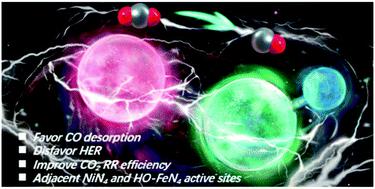当前位置:
X-MOL 学术
›
Energy Environ. Sci.
›
论文详情
Our official English website, www.x-mol.net, welcomes your
feedback! (Note: you will need to create a separate account there.)
Quasi-double-star nickel and iron active sites for high-efficiency carbon dioxide electroreduction
Energy & Environmental Science ( IF 32.4 ) Pub Date : 2021-07-19 , DOI: 10.1039/d1ee01592c Ting Zhang 1, 2, 3, 4, 5 , Xu Han 1, 2, 3, 4, 5 , Hong Liu 6, 7, 8, 9 , Martí Biset-Peiró 5, 10, 11, 12, 13 , Xuan Zhang 14, 15, 16, 17, 18 , Pingping Tan 19, 20, 21, 22, 23 , Pengyi Tang 24, 25, 26, 27, 28 , Bo Yang 6, 7, 8, 9 , Lirong Zheng 9, 29, 30, 31, 32 , Joan Ramon Morante 5, 10, 11, 12, 13 , Jordi Arbiol 1, 2, 3, 4, 5
Energy & Environmental Science ( IF 32.4 ) Pub Date : 2021-07-19 , DOI: 10.1039/d1ee01592c Ting Zhang 1, 2, 3, 4, 5 , Xu Han 1, 2, 3, 4, 5 , Hong Liu 6, 7, 8, 9 , Martí Biset-Peiró 5, 10, 11, 12, 13 , Xuan Zhang 14, 15, 16, 17, 18 , Pingping Tan 19, 20, 21, 22, 23 , Pengyi Tang 24, 25, 26, 27, 28 , Bo Yang 6, 7, 8, 9 , Lirong Zheng 9, 29, 30, 31, 32 , Joan Ramon Morante 5, 10, 11, 12, 13 , Jordi Arbiol 1, 2, 3, 4, 5
Affiliation

|
Although the Faraday efficiencies (FEs) obtained on most of the Ni based single-atom catalysts (Ni–N–C) are satisfactory (generally >90%) for the electrochemical transfer CO2 to CO, their practical application is still limited by their high overpotentials (>600 mV vs. RHE), which implies a higher energy consumption to drive the CO2 RR. In this work, we have prepared a quasi-double star catalyst composed of nearby Ni and Fe active sites via a simple pyrolysis of Ni and Fe co-doped Zn-based MOFs in order to achieve a high selectivity at a low overpotential during the CO2 RR. Specifically, the optimized Ni/Fe–N–C catalyst shows an exclusive selectivity (a maximum FE(CO) of 98%) at a low overpotential of 390 mV vs. RHE, which is superior to both the single metal counterparts (Ni–N–C and Fe–N–C catalysts) and other state-of-the-art M–N–C catalysts. The DFT results further reveal that regulating the catalytic CO2 RR performance via nearby Ni and Fe active sites can potentially break the activity benchmark of the single metal counterparts because the neighboring Ni and Fe active sites not only function in synergy to decrease the reaction barrier for the formation of COOH* and desorption of CO* in comparison to their single metal counterparts, but also prevent the undesired hydrogen evolution reaction (HER). This work presents a quasi-double-star catalyst composed of two metal sites for high-efficiency CO2 reduction, which paves the way for the rational design of bimetallic catalysts with separated active sites for other reactions.
中文翻译:

用于高效二氧化碳电还原的准双星镍铁活性位点
尽管在大多数镍基单原子催化剂(Ni-N-C)上获得的法拉第效率(FEs)对于将 CO 2电化学转移到 CO是令人满意的(通常> 90%),但它们的实际应用仍然受到它们的限制高过电位(>600 mV vs. RHE),这意味着驱动 CO 2 RR 的能量消耗更高。在这项工作中,我们通过对 Ni 和 Fe 共掺杂的 Zn 基 MOF 进行简单的热解制备了一种由附近 Ni 和 Fe 活性位点组成的准双星催化剂,以便在 CO 过程中以低过电位实现高选择性。2 RR。具体而言,优化的 Ni/Fe-N-C 催化剂在 390 mV 的低过电位下显示出独特的选择性(最大 FE(CO) 为 98%)与RHE相比,它优于单一金属对应物(Ni-N-C 和 Fe-N-C 催化剂)和其他最先进的 M-N-C 催化剂。DFT 结果进一步表明,通过附近的 Ni 和 Fe 活性位点调节催化 CO 2 RR 性能可能会打破单金属对应物的活性基准,因为相邻的 Ni 和 Fe 活性位点不仅协同作用降低反应势垒与它们的单一金属对应物相比,COOH* 的形成和 CO* 的解吸,而且还防止了不希望的析氢反应 (HER)。这项工作提出了一种由两个金属位点组成的准双星催化剂,用于高效 CO 2 还原,这为合理设计具有分离活性位点用于其他反应的双金属催化剂铺平了道路。
更新日期:2021-08-07
中文翻译:

用于高效二氧化碳电还原的准双星镍铁活性位点
尽管在大多数镍基单原子催化剂(Ni-N-C)上获得的法拉第效率(FEs)对于将 CO 2电化学转移到 CO是令人满意的(通常> 90%),但它们的实际应用仍然受到它们的限制高过电位(>600 mV vs. RHE),这意味着驱动 CO 2 RR 的能量消耗更高。在这项工作中,我们通过对 Ni 和 Fe 共掺杂的 Zn 基 MOF 进行简单的热解制备了一种由附近 Ni 和 Fe 活性位点组成的准双星催化剂,以便在 CO 过程中以低过电位实现高选择性。2 RR。具体而言,优化的 Ni/Fe-N-C 催化剂在 390 mV 的低过电位下显示出独特的选择性(最大 FE(CO) 为 98%)与RHE相比,它优于单一金属对应物(Ni-N-C 和 Fe-N-C 催化剂)和其他最先进的 M-N-C 催化剂。DFT 结果进一步表明,通过附近的 Ni 和 Fe 活性位点调节催化 CO 2 RR 性能可能会打破单金属对应物的活性基准,因为相邻的 Ni 和 Fe 活性位点不仅协同作用降低反应势垒与它们的单一金属对应物相比,COOH* 的形成和 CO* 的解吸,而且还防止了不希望的析氢反应 (HER)。这项工作提出了一种由两个金属位点组成的准双星催化剂,用于高效 CO 2 还原,这为合理设计具有分离活性位点用于其他反应的双金属催化剂铺平了道路。











































 京公网安备 11010802027423号
京公网安备 11010802027423号